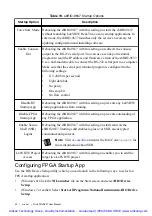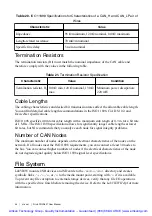
•
The signal leads travel through noisy environments.
•
Two analog input channels, AI+ and AI-, are available for the signal.
DIFF signal connections reduce noise pickup and increase common-mode noise rejection.
DIFF signal connections also allow input signals to float within the common-mode limits of
the PGIA.
When to Use Referenced Single-Ended (RSE) Connections with Floating
Signal Sources
Only use RSE input connections if the input signal meets the following conditions:
•
The input signal can share a common reference point, AI GND, with other signals that
use RSE.
•
The input signal is high-level (greater than 1 V).
•
The leads connecting the signal to the device are less than 3 m (10 ft).
DIFF input connections are recommended for greater signal integrity for any input signal that
does not meet the preceding conditions.
In the single-ended modes, more electrostatic and magnetic noise couples into the signal
connections than in DIFF configurations. The coupling is the result of differences in the signal
path. Magnetic coupling is proportional to the area between the two signal conductors.
Electrical coupling is a function of how much the electric field differs between the two
conductors.
With this type of connection, the NI sbRIO device rejects both the common-mode noise in the
signal and the ground potential difference between the signal source and the device ground.
Using Differential Connections for Floating Signal Sources
You must connect the negative lead of a floating source to AI GND (either directly or through
a bias resistor). Otherwise, the source may float out of the maximum working voltage range of
the PGIA device and return erroneous data.
The preferred method for referencing the source to AI GND is to connect the positive side of
the signal to AI+ and connect the negative side of the signal to AI GND as well as to AI-
without using resistors, as shown in the following figure. This connection works well for DC-
coupled sources with source impedance less than 100 Ω.
Figure 26. Differential Connections for Floating Signal Sources without Bias Resistors
–
+
Impedance
<100
Ω
AI GND
AI+
AI–
V
s
Floating
Signal
Source
However, for larger source impedances, this connection leaves the DIFF signal path
significantly off balance. Noise that couples electrostatically onto the positive signal does not
34
|
ni.com
|
NI sbRIO-9637 User Manual
Artisan Technology Group - Quality Instrumentation ... Guaranteed | (888) 88-SOURCE | www.artisantg.com














































